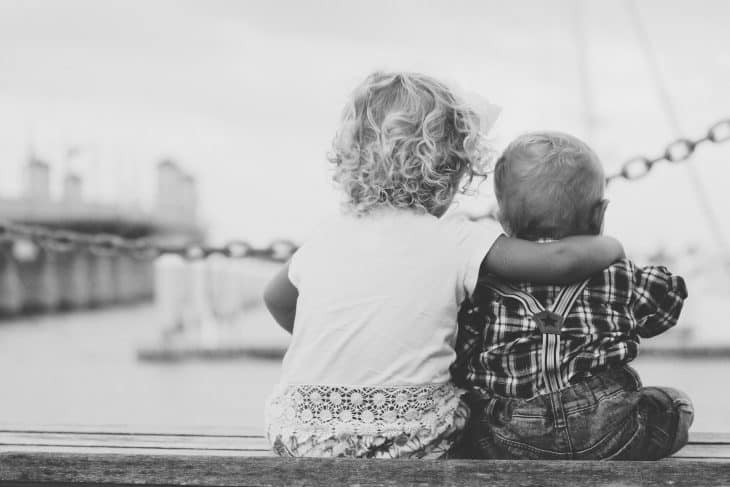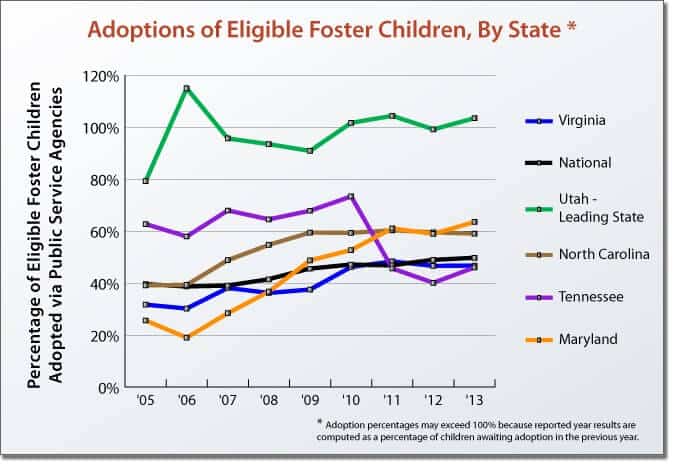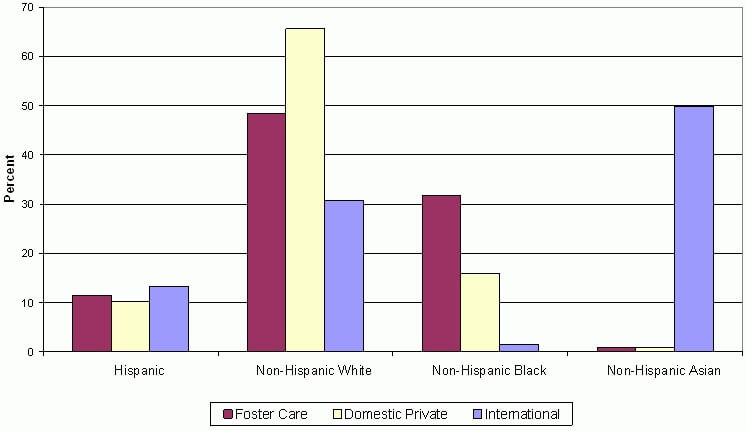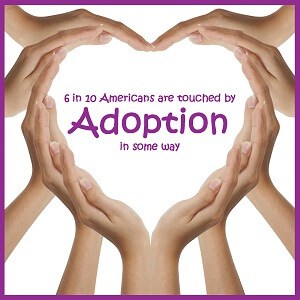
- Earliest Known Adoption: The Pharaoh’s daughter adopted baby Moses in the Bible
- Earliest Adoption Law: Code of Hammurabi
- First Modern Adoption Law: Enacted by Commonwealth of Massachusetts in 1851
- Population: 18 million orphans worldwide
- Largest Adoptive Parent Group: Couples who have been married for 3 years or more
- Adoption Rates: The highest adoption rate was recorded in 1985 in South Korea – 1.3% of all children were sent overseas for adoption
- US Adoptions: The US adopts more children internationally and locally that the rest of the world combined
- International Adoptions: In 2009, US citizens adopted 13,000 children from 106 different countries
- Social Opinion: 63% of Americans view adoption favourably
- Social Opinion: 95% of Americans think adoptive parents should receive the same maternity and paternity benefits from employers as biological parents
- Reasons: Most Adoptions Occur Because Of Infertility
- Statistics: More Than 60% of Orphans Spend Up To 5 Years in Foster Care Before Being Adopted
- Interracial Adoptions: One in Three Children Adopted from Foster Care Are Adopted by Parents of Another Race
- Families: Adopted Families Have More Complex Structures
- Cost: An Adoption Can Cost Up To $50,000
- Open Adoption: Seven US States Legally Enforce Open Adoption
- LGBT Adoption: LGBT Adoptions Are Not Legal Everywhere
- New Restrictions in China Slowed International Adoptions
- Adopted Children Experience More Social Success and Happiness
- The Phrase Put Up For Adoption Comes from the Orphan Train Movement
- Science and Social Mores Challenged the Stigma of Adoption
- Celebrities Such as Jamie Foxx and Nicole Richie Were Adopted
- Ancient Adoption Was for Economic and Political Reasons
- Animal Communities Also Display Adoptive Behaviour
Most Adoptions Occur because of Infertility
There are many reasons why people choose to adopt. One of the less surprising adoption facts is that 95% of people who adopt do so because of issues with fertility. Other reasons to adopt may include: compassion, an unwillingness to add to the worldwide problem of overpopulation, health concerns regarding pregnancy and childbirth, and to avoid passing on inheritable diseases.
60% of Orphans Spend up to Five Years in Foster Care before Being Adopted

Adoption facts reveal that 60% of the children in the foster care system remain under this type of care for two to five years before being adopted. Nearly one in five children in this system remains in foster care for five years or more before being adopted. Unfortunately, some of these children are never adopted.
One in Three Children Adopted from Foster Care Is Adopted by Parents of Another Race

One of the more interesting adoption facts is that one-third of all children who are adopted from foster care are adopted by parents of another race. Most children who are adopted from foster care are non-white.
This is in stark contrast to the parents who adopt children from foster care, the vast majority of whom (73%) are white. Many people are opposed to transracial adoptions. In fact, the National Association of Black Social Workers in the US regards this type of adoption as racial genocide.
Adopted Families Have More Complex Structures
Children who are adopted from foster care tend to be adopted into families with more complex structures than those experienced by other adopted children.
This is largely because 40% of children who are adopted from foster care are adopted into families where there are already at least three other adopted and birth children. This creates a far more complex family structure.
An Adoption Can Cost Up To $50,000
Of all adoption facts, one of the most surprising is that both domestic and international adoptions have similar costs. Any adoption can cost in the range of $25,000 to $50,000.
However, there are unique costs attributed to domestic and international adoptions. International adoptions often incur additional expenses, such as the cost of visas. On the other hand, parents who adopt locally often have to pay for the birth mother’s medical bills, and sometimes her rent and other living expenses. Other factors that have been shown to affect the cost of an adoption include the race, age, sex, and origin of the child.
Seven US States Legally Enforce Open Adoption

There are seven states in the US that legally enforce open adoption. These states are: California, Indiana, Nebraska, Minnesota, Oregon, Washington, and New Mexico.
In fact, adoption facts teach us that up to 70% of all domestic adoptions in the US are now open adoptions. An open adoption means that there is a greater degree of openness and disclosure of information between the birth and adoptive parents and the adopted child.
The adoptive parents meet the birth parents, sometimes choosing to stay in contact, especially with the birth mother. This type of adoption is becoming more common, as opposed to closed adoption, where the birth parents remain anonymous.
LGBT Adoptions Are Not Legal Everywhere
LGBT adoptions are adoptions where the adoptive parents are lesbian, gay, bisexual, or transgender persons. This is one of the more controversial adoption facts, and the legal status of this type of adoption varies between, and within, countries.
It is estimated that 65,500 adopted American children have a gay or lesbian adoptive parent. Interestingly, statistics show that same sex adoptive couples tend to be older, more educated, and have more economic resources than other adoptive parents.
New Restrictions in China Slowed International Adoptions
China introduced new restrictions for foreign adoptions in May 2007. According to the new rules, a single woman may only adopt a child if she adopts a special needs child, and if she signs an affidavit stating that she is not homosexual.
In addition, you may not adopt a child from China if you are over 50 years old, morbidly obese, have a facial deformity, have taken antidepressants or anti-anxiety medication for a serious mental disorder in the last two years, are blind, have schizophrenia, or are terminally ill. You also have to meet certain educational requirements.
Couples who want to adopt must have been married for at least two years. However, if one of the prospective parents has been divorced and is now remarried, the couple has to have been married for a minimum of five years before they can adopt. Lastly, a family has to earn an annual income of at least $10,000 per family member, and have a minimum of $80,000 in assets.
Adoption facts show that the number of international adoptions from China fell dramatically after the introduction of these rules.
Adopted Children Experience More Social Success and Happiness
If you thought adopted children were more likely to be damaged, then adoption facts will prove you wrong. On the vast majority of measures that look at social success and happiness, adopted children rate highly compared to other children. Some of these findings include the facts that adopted children are less likely to be delinquent. They are also less likely to live in poverty when compared to children living in single parent homes. In fact, they are more more likely to finish school, have a better job, and to go on to enjoy a stable marriage.
The Phrase Put Up For Adoption Comes from the Orphan Train Movement
The phrase put up for adoption comes from the orphan train movement, which took place in the United States from 1854 to 1929. Orphans were put on trains due for the Midwestern and Western states in the hope that they would find homes.
At every stop along the way, these children were put up on the station platforms to see if anyone wanted to take them home, hence the phrase put up for adoption. This practice was heavily criticised, and led to the establishment of agencies and laws to investigate and govern all adoptions.
Science and Social Mores Challenged the Stigma of Adoption
In the late 1800s and early 1900s there were many popular Western ideas about eugenics. These beliefs focused on improving the genetic quality of the human population.
Accordingly, families were discouraged from adopting children from unknown origins as these children might be from poor or degenerate stock. This stigma was challenged as the rate of adoptions increased from the mid-1940s to the 1970s. This was due to several factors: the number of illegitimate births tripled in this time, sexual mores were changing and becoming less conservative, and science challenged eugenic stigmas by emphasising the importance of nurture over nature.
Celebrities Such as Jamie Foxx and Nicole Richie Were Adopted

Many celebrities were adopted as children. The list of famous people who were adopted includes: Jamie Foxx, Nicole Richie, Ray Liotta, Faith Hill, Jack Nicholson, Steve Jobs, Frances McDormand, Debbie Harry (‘Blondie’), Gary Coleman, Melissa Gilbert, and Scott Hamilton.
Ancient Adoption Was for Economic and Political Reasons
Adoption facts emphasise the fact that adoption is now seen as a means to provide homeless and needy children with a stable family structure and family life.
However, this was not the case in ancient times. On the contrary, adoption in the West was seen as a legal and political tool that was used solely to serve the political and economic interests of the adoptive parents. Adoption was used to create ties between families, and to provide male heirs to manage the family estates. In the East, adoption during ancient times was seen as a way to preserve cultural and religious practices and ensure their continuity.
Animal Communities Also Display Adoptive Behaviour
There are several adoption facts pertaining to the animal world. Researchers have observed adoptive behaviour in a number of different animal communities. One example is among chacma baboons. Baby chacma baboons that lose their mothers are adopted by young adult baboons in their social group. These adoptive parents carry, groom and protect these adopted youngsters.
Adoption Facts – Facts about Adoption Summary
 Adoption has occurred in society for centuries. However, there are now more laws and regulations governing adoption. Open adoptions are more common, whilst other issues such as LGBT adoptions remain controversial with no unanimous opinion or laws.
Adoption has occurred in society for centuries. However, there are now more laws and regulations governing adoption. Open adoptions are more common, whilst other issues such as LGBT adoptions remain controversial with no unanimous opinion or laws.
Was this page helpful?
Our commitment to delivering trustworthy and engaging content is at the heart of what we do. Each fact on our site is contributed by real users like you, bringing a wealth of diverse insights and information. To ensure the highest standards of accuracy and reliability, our dedicated editors meticulously review each submission. This process guarantees that the facts we share are not only fascinating but also credible. Trust in our commitment to quality and authenticity as you explore and learn with us.
